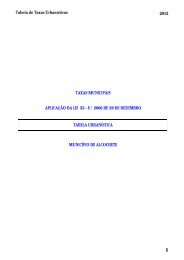Plano Nacional de Acção para a Inclusão 2006-2008 - Instituto ...
Plano Nacional de Acção para a Inclusão 2006-2008 - Instituto ...
Plano Nacional de Acção para a Inclusão 2006-2008 - Instituto ...
You also want an ePaper? Increase the reach of your titles
YUMPU automatically turns print PDFs into web optimized ePapers that Google loves.
<strong>Plano</strong> <strong>Nacional</strong> <strong>de</strong> Acção <strong>para</strong> a Inclusão <strong>2006</strong>-<strong>2008</strong>Anexo IImediano) e a própria linha <strong>de</strong> pobreza, expressa em percentagem dalinha <strong>de</strong> pobreza.Relative median poverty risk gap da população total1995 1996 1997 1998 1999 2000 2001 2004Portugal 28 26 25 26 23 25 22 26Homens 28 26 24 26 22 24 22 25Mulheres 28 26 26 26 23 25 24 27UE25 - - - - - - 22 23Homens - - - - - - 22 -Mulheres - - - - - - 22 -Relative median poverty risk gap das crianças1995 1996 1997 1998 1999 2000 2001 2004Portugal 31 31 26 28 20 25 22 29UE25 - - - - - - 23 24Relative median poverty risk gap dos adultosem ida<strong>de</strong> activa (16-64 anos)1995 1996 1997 1998 1999 2000 2001 2004Portugal 31 27 26 26 23 25 22 29Homens 31 27 24 26 24 24 22 29Mulheres 31 27 27 26 23 25 22 30UE25 - - - - - - 23 25Homens - - - - - - 23 25Mulheres - - - - - - 23 25Relative median poverty risk gap dos idosos (65 + anos)1995 1996 1997 1998 1999 2000 2001 2004Portugal 26 23 23 24 23 23 22 18Homens 25 21 20 20 20 23 22 17Mulheres 26 25 25 26 24 23 22 19UE25 - - - - - - 16 16Homens - - - - - - 17 15Mulheres - - - - - - 17 16Fonte: ECHP e SILC 2004, EurostatNota: Quebra <strong>de</strong> série em 2004SI-P5: TAXA DE DESEMPREGO DE LONGA DURAÇÃO PORGRUPO ETÁRIOTotal da população em situação <strong>de</strong> <strong>de</strong>semprego <strong>de</strong> longa duração (12meses ou mais), expresso em percentagem do total da população activa.Taxa <strong>de</strong> <strong>de</strong>semprego <strong>de</strong> Longa Duração2000 2001 2002 2003 2004 2005Portugal 1,7 1,5 1,7 2,2 3,0 3,7Homens 1,4 1,2 1,4 1,8 2,6 3,2Mulheres 2,0 1,9 2,1 2,7 3,4 4,2UE25 3,9 3,8 3,9 4,1 4,1 3,9Homens 3,3 3,2 3,3 3,6 3,6 3,5Mulheres 4,8 4,6 4,6 4,7 4,7 4,5Fonte: LFS, EurostatSI-P6: PESSOAS A VIVER EM AGREGADOS FAMILIARESDESEMPREGADOSPercentagem <strong>de</strong> crianças (0-17 anos) e adultos(18-59 anos) que vivemem agregados on<strong>de</strong> ninguém trabalha (homens /mulheres).1995 1996 1997 1998 1999 2000 2001 2002 2003 2004 2005Portugal 5,9 6,3 5,9 5.1 b 4,7 4,6 4,3 4,6 5,5 5,3 5,5População em agregadosfamiliares <strong>de</strong>sempregados18-59 anos: mulheres6,8 7,3 7,0 6.1 b 5,3 5,1 4,9 5,2 6,1 5,7 5,8População em agregadosfamiliares <strong>de</strong>sempregados18-59 anos: homensCrianças em agregadosfamiliares <strong>de</strong>sempregados0-17 anos5,0 5,1 4,85,1 5,1 5,2UE25 - - - - - -4.0b4.6b4,1 4,1 3,7 3,9 4,8 5,0 5,14,5 3,9 3,6 4,2 5,0 4,3 4,310.1e10.2e10.2e10.4pFonte: LFS, Eurostat(e) Valor estimado(p) Valor provisório10.2p144145












